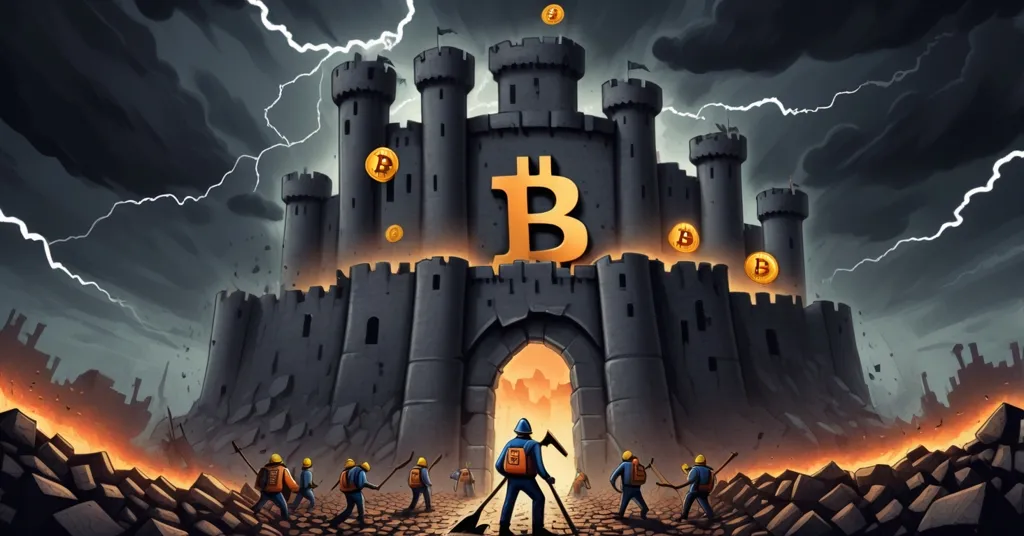Ethereum Researcher Slams Bitcoin Security Over Low Fee Crisis

Ethereum Researcher Warns of Bitcoin’s Security Flaws Tied to Low Transaction Fees
Bitcoin, the pioneer of decentralized money, faces a looming security threat that could jeopardize its dominance and send shockwaves through the crypto world. Ethereum Foundation researcher Justin Drake has sounded the alarm, pointing to Bitcoin’s declining transaction fees as a critical flaw in its Proof of Work (PoW) system. With fees at historic lows, the network’s ability to incentivize miners—and thus protect itself from attacks—hangs in a precarious balance, sparking fierce debate across the community.
- Fee Crisis: Bitcoin transaction fees have fallen for 13 years, averaging just 6.5 BTC per day, a mere 1% of miner revenue.
- Security Risk: Low fees could lead to reduced miner participation, making a 51% attack more feasible at a cost of $5-20 billion.
- Controversial Fixes: Proposals like expanding Bitcoin’s 21 million supply cap or switching to Proof of Stake (PoS) face staunch opposition.
The Fee Drought: Miners Struggling to Stay Afloat
Bitcoin’s transaction fees, the lifeblood for miners who secure the network by solving complex puzzles with raw computing power (known as hash rate), have been drying up for over a decade. The latest figures show a 30-day moving average of just 6.5 BTC per day, contributing a measly 1% to miners’ total income. Most of their revenue still comes from block rewards—newly minted Bitcoin handed out for each block mined (think of it as a shrinking paycheck). But with Bitcoin’s hard cap at 21 million coins and periodic halvings slashing these rewards roughly every four years, miners will eventually depend entirely on fees. If current trends hold, that could mean a near-total revenue collapse when the last Bitcoin is mined around 2140. Worse yet, adjusted for inflation, Bitcoin’s security budget—the real-world value of rewards and fees protecting the network—has dropped over 45% in the last four years as of early 2025. That’s a staggering decline for a system meant to be impenetrable, as highlighted in recent community discussions on declining security budgets.
Why have fees tanked so hard? Part of it comes down to off-chain solutions like the Lightning Network, a layer-2 scaling system that handles transactions outside the main blockchain, reducing on-chain fee pressure. While this boosts Bitcoin’s usability for small payments, it starves miners of income. Historical data paints an even bleaker picture: fee revenue as a percentage of miner income has consistently shrunk since Bitcoin’s early days, even during bull runs. Back in 2013, fees often made up 5-10% of rewards; now they’re a rounding error. Without a sustainable income stream, miners might pack up their rigs, leaving the network’s hash rate—the collective muscle keeping it safe—dangerously thin, a concern echoed in online forums discussing miner revenue challenges.
51% Attack: A Real Threat or Overblown Fear?
Justin Drake isn’t pulling punches when he calls Bitcoin’s security model broken. In a PoW setup, miners’ hash rate acts as a fortress against attacks. But if fees can’t keep miners in the game, that fortress starts crumbling. The worst-case scenario is a 51% attack, where a bad actor gains control of over half the network’s computing power, allowing them to rewrite transaction history, double-spend coins, or sabotage the blockchain. Drake estimates such an attack could cost as little as $20 billion even if Bitcoin’s market cap hits a mind-boggling $200 trillion. Independent research backs this up, pegging the Cost of Attack (CoA) between $5-20 billion, potentially even less due to secondary markets for older, cheaper mining gear that lowers the entry barrier for attackers, as noted in analyses of 51% attack risks.
“Bitcoin’s security model is broken. If Bitcoin gets taken over, the fallout could take the entire crypto ecosystem. The systemic risks can’t be ignored.” – Justin Drake, Ethereum Foundation
Let’s run the numbers on a dream scenario: Bitcoin’s price soars to $1 million per coin. Even then, maintaining today’s fee level of 6.5 BTC per day equals just $6.5 million in daily fees—a pathetic 10% of the current security budget. A $20 trillion asset would be guarded by a sliver of today’s protective power. And there are specific windows of weakness, like during halving events when hash rates often dip as miners shut down unprofitable rigs, making Bitcoin up to three times easier to attack temporarily. Then there’s the concept of “Goldfinger attacks”—think of a rogue state or billionaire shorting Bitcoin’s price, then orchestrating a network takedown for profit or chaos. Sounds like a Hollywood plot, doesn’t it? But the math adds up, and that’s what keeps Bitcoin developers sweating at night, especially with insights from Drake’s warnings on fee-related vulnerabilities.
“Let’s be optimistic and say BTC rises to $1M, and today’s 6.5 BTC/day in fees is maintained: $6.5M/day in fees, 10% of today’s security budget. Bitcoin would be a $20T asset secured by 1/10th of today’s hashing infrastructure.” – Justin Drake
Failed Fixes: Why Innovation Hasn’t Saved the Day
Bitcoin hasn’t been blind to the fee problem. Over the years, projects aimed at boosting transaction activity—and thus fees—have emerged. Ordinals, for instance, lets users inscribe NFT-like data on Bitcoin’s blockchain, briefly spiking fees in 2023. Others like Liquid, Omni, and Babylon have tried similar approaches to drive network usage. But these are Band-Aids at best, creating short-lived surges without lasting impact. The core issue remains: Bitcoin’s base layer isn’t built for high transaction volume by design—it prioritizes security and decentralization over throughput. Layer-2 solutions help with scaling, but they siphon fees away from miners. So, if tinkering within the current rules isn’t working, what’s the next move? The mechanics of Bitcoin fees show how deeply tied they are to network protection.
Radical Proposals vs. Bitcoin’s Sacred Principles
Drake tosses out some ideas that might make Bitcoin purists clutch their hardware wallets in horror. One is expanding the hallowed 21 million supply cap to keep block rewards flowing indefinitely, ensuring miners get paid even after the last coin is mined. Another is ditching PoW for Proof of Stake (PoS), the consensus system Ethereum switched to in 2022 during “The Merge.” In PoS, validators lock up coins to secure the network instead of burning energy on mining, theoretically dodging the fee dependency trap. But let’s get real—suggesting changes to Bitcoin’s core DNA is like asking a monastery to install slot machines. The community, especially Bitcoin maximalists who treat the protocol as untouchable, would sooner mine with paper and pencil than agree to such blasphemy, a tension evident in recent critiques from Ethereum researchers.
Other Ethereum researchers have pitched less explosive ideas. Ansgar Dietrichs suggests ending congestion pricing—where fees skyrocket during network traffic jams—and setting a higher minimum fee floor to guarantee miners a baseline income. He even floats wild concepts like turning Bitcoin into a Layer-2 solution on a PoS chain or an ERC-20 token on Ethereum. Creative? Sure. Feasible? Not when Bitcoin’s ethos is rooted in resisting any change that smells of centralization or compromise. Every proposed fix, from supply tweaks to consensus overhauls, demands a hard fork—a contentious split in the network that historically divides communities (just look at Bitcoin Cash). Bitcoin’s cultural wall against change might be its biggest strength and its greatest weakness.
Pushback: Is This Fearmongering or a Valid Warning?
Not everyone’s ready to sound the apocalypse alarm. Kushal Babel of Category Labs argues we should measure fees in USD, not BTC, to gauge their real impact on security. If fees hold steady or grow in dollar terms due to price appreciation, the picture might not be as grim as Drake paints it, a perspective detailed in Babel’s analysis of fee evaluations. Bitcoin maximalists like Udi Wizardheimer go further, scoffing at the critique with a “glass houses” jab—Ethereum’s own PoS system has centralization risks, with a handful of stakers controlling massive influence post-Merge. Why lecture Bitcoin on hypothetical flaws when your own backyard’s a mess? Let’s not pretend Drake’s warning is pure goodwill; pointing fingers at Bitcoin could be a convenient distraction from Ethereum’s skeletons.
They’ve got a point worth chewing on. Smaller PoW blockchains with tiny security budgets—like Ethereum Classic—have already been hit by 51% attacks, suffering chain reorganizations and double-spends, yet Bitcoin’s sheer scale still offers a beefy shield, even if it’s thinning. Bitcoin’s track record of uptime and resilience is unmatched; no major attack has ever succeeded despite endless predictions of doom. Is the fee issue a genuine crisis, or an overblown distraction from other flaws across the crypto space? Playing devil’s advocate, one could argue Bitcoin’s scarcity-driven model forces innovation—perhaps new use cases or layer-2 fee-sharing mechanisms will emerge. Still, ignoring systemic risks feels like betting a trillion-dollar ecosystem on “it’ll be fine.”
The Bigger Picture: A Test for Decentralization
Bitcoin isn’t just another project—it’s the flagship of decentralized finance. If its security falters, the fallout could shatter trust in blockchain tech altogether. Picture a successful 51% attack in 2030: markets crater, regulators swoop in with suffocating rules, and the vision of censorship-resistant money takes a decade-long hit. Past crises like the Mt. Gox hack in 2014 showed how Bitcoin’s stumbles ripple outward; a security breach today would be orders of magnitude worse. Drake’s warning, while inconvenient for die-hard hodlers, forces us to grapple with hard truths about sustaining a system built on scarcity over adaptability.
Yet there’s room for optimism if we lean into effective accelerationism. Innovations like Taproot and Schnorr signatures, already live, could unlock new use cases for Bitcoin, indirectly boosting transaction demand and fees. The community’s stubbornness isn’t just blind tradition—it’s a bulwark against creeping centralization, a reminder of why Bitcoin exists to disrupt the status quo. The fee crisis tests whether true decentralization can weather economic realities. Will Bitcoin adapt without betraying its roots, or cling to purity at all costs? As halvings keep eroding block rewards, this slow-burning fuse isn’t going anywhere. We’re left watching, debating, and hoping Bitcoin’s grit outmatches the cunning of potential attackers.
Key Questions on Bitcoin’s Security Challenges
- What’s behind Bitcoin’s security concerns?
Transaction fees have plummeted for 13 years to just 6.5 BTC per day, only 1% of miner revenue, risking lower hash rate and exposure to attacks. - Will a higher Bitcoin price solve the problem?
Not per Justin Drake; even at $1 million per BTC, fees would fund just 10% of today’s security budget, leaving the network dangerously underprotected. - How serious is the risk of a 51% attack?
It’s a credible threat, with attack costs estimated at $5-20 billion—potentially less with cheap hardware—while the security budget has shrunk 45% in real value over four years. - Why are solutions like PoS or supply changes so divisive?
They violate Bitcoin’s core tenets of immutability and decentralization, ensuring rejection by a community that views such changes as betrayal. - Should we take Ethereum researchers’ critiques seriously?
Despite rivalry-driven bias, their concerns echo independent studies on PoW weaknesses, meaning dismissing them outright risks ignoring real vulnerabilities.



